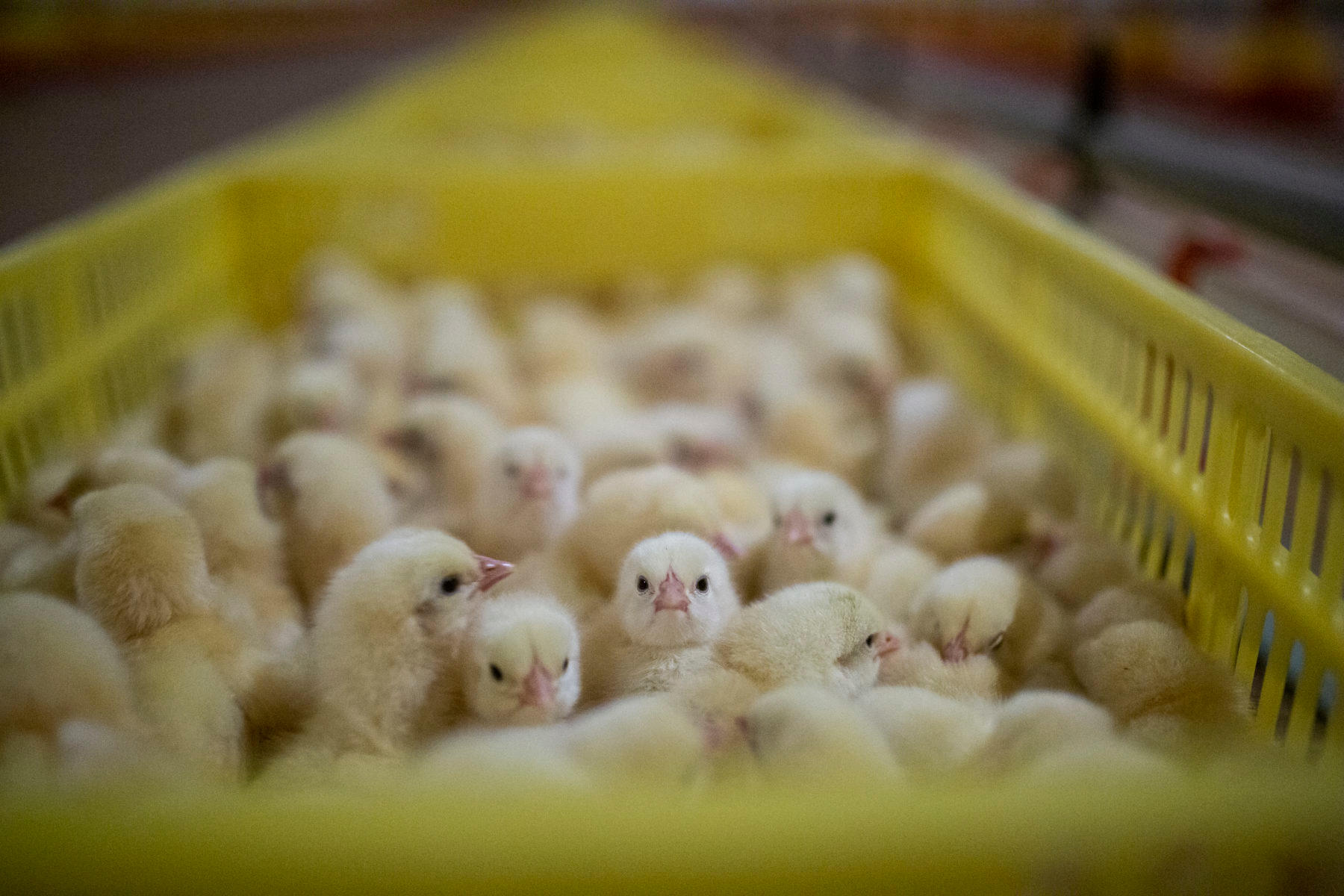




The US government enacted the Humane Slaughter Act decades ago to extend basic protections to animals in slaughterhouses. However, the law leaves out billions of animals, and its protections are often unenforced.

The Humane Slaughter Act has been a part of US law, in one form or another, since the 1950s. The law is meant to ensure that animals are made quickly and effectively unconscious before they’re killed for meat production, but the act has many shortcomings and blind spots. Not only are some of the most commonly slaughtered animals—like chicken and fish—excluded from the act’s protections, but various investigations and inside reports over the years have shown how slaughterhouses have historically ignored this law, and gotten away with it.
What is the 1958 Humane Slaughter Act?
The 1958 Humane Slaughter Act, also known as the Humane Methods of Slaughter Act (HMSA), is a piece of legislation signed into law by President Dwight D. Eisenhower. It requires "humane treatment and handling," as well as a "quick and effective death" for animals who are killed at slaughterhouses.
The US Department of Agriculture (USDA) Food Safety & Inspection Service is responsible for enforcing this law. Federal inspectors may halt production at a meat slaughter facility that has committed a violation, however, there's no "general enforcement provision" included in the HMSA, so the USDA's authority in enforcing it is quite limited. The law initially included an enforcement provision, but Congress repealed it in 1978. This essentially means that offending slaughterhouses don't have to worry about getting prosecuted for a criminal offense—as long as they "fix" their inhumane slaughter methods, they can continue operations as usual.
Worse yet, the protections in this law do not extend to fish or birds—despite chickens being the most widely consumed animals in the country. This means that roughly 9 billion chickens, 270 million turkeys, and 24 million ducks are slaughtered every year in the US, all without any protection from the government. Some animals who get sick or injured on factory farms are killed before they ever make it to a slaughterhouse—unfortunately, farmers are exempt from following the regulations laid out by the Humane Slaughter Act.
The HMSA provides the Secretary of Agriculture with the authority to create regulations regarding the treatment of "nonambulatory livestock," animals who are unable to stand and move on their own. Slaughterhouses, for example, cannot move conscious, nonambulatory animals by dragging them.
What is considered humane slaughter?
It may seem counterintuitive to consider any form of slaughter to be humane, and there are certainly many animal activists who argue that the systemic killing of sentient animals is inherently inhumane, no matter how it is carried out.
However, as far as the federal government is concerned, "humane slaughter,", does have a definition, and it's been codified in official government documents. These requirements apply to livestock from their arrival at a slaughter plant, up until the moment these animals are killed. The idea is to prevent "needless" distress or pain during the slaughtering process.
The HMSA defines a "humane method" of slaughter as one wherein livestock are "rendered insensible to pain by a single blow or gunshot or an electrical, chemical or other means that is rapid and effective." Religious ceremonies of animal slaughter, however, are exempt from this.
More specific guidelines for humane slaughter have been articulated in the Code of Federal Regulations, including:
-
Livestock pens, driveways, ramps, and floors must be kept in good condition, free of any sharp or protruding objects that could cause injury to the animals.
-
Livestock must be moved from one place to another in a way that causes minimal "excitement and discomfort" to the animals. Electric prods, canvas slappers, or other implements used to drive animals should be used as infrequently as possible, and sharp, pointed objects should not be used to drive livestock.
-
Animals must have access to water in all holding pens and, if held longer than 24 hours, access to feed.
-
Those held overnight in a pen must have enough room to lie down.
-
Animals must be effectively stunned before they are "shackled, hoisted, thrown, cast, or cut."
There are several slaughtering methods approved by the USDA, including the use of carbon dioxide gas, captive bolt stunners, firearms, and electric current. In all cases, the Humane Slaughter Act dictates that animals must be made unconscious—or otherwise made unconscious—so that the slaughtering method does not cause the animals any pain.
The problem with this, however, is that stunning doesn't always work. In recent years animal rights watchdog groups have documented various instances in which stunning methods used at slaughterhouses were ineffective, meaning that the animals were conscious—able to feel fear, distress, and physical pain—at the time of their slaughter.
Why was the Humane Slaughter Act created?
General concerns about the lack of oversight in the meat industry had been brewing in the United States since the early 1900s. Most notably, muckraking journalist Upton Sinclair's 1906 novel The Jungle exposed rampant corruption and unsanitary conditions in Chicago's meatpacking plants, spurring a movement for better government regulations on the meat Americans were consuming. By 1958, public outcry for anti-cruelty measures in the country's slaughterhouses had grown so prominent that President Eisenhower commented, "If I went by mail, I'd think no one was interested in anything but humane slaughter."
History of the Humane Slaughter Act
1958: Responding to pressure from the public, Congress passed the first incarnation of the Humane Slaughter Act. Eisenhower signed it into law in August of that year. The act stated that livestock such as bulls, pigs, and sheep must be slaughtered using "humane" methods so that these animals did not experience pain. However, the law was remarkably limited and only applied to slaughterhouses that sold meat to the federal government.
1978: Twenty years after the original law's passage, Congress expanded the breadth of the Humane Slaughter Act to apply to all federally inspected slaughterhouses. In addition, the modified act specified that livestock animals—birds and fish still excluded—be made unconscious rapidly and effectively before slaughter.
2002: In years leading up to the 2002 Farm Bill, reports and hidden video tapes revealed that all over the country, a lack of enforcement by the USDA had led to countless cases in which cattle, hogs, sheep, and other "livestock" animals were ineffectively stunned before slaughter. As a result, thousands of animals had been subjected to horrifyingly inhumane deaths—being drowned, scalded, or skinned—all while fully awake, audibly crying out for mercy, visibly moving to try and escape. In response to these increasingly frequent reports, Congress included a section in the 2002 Farm Bill that called on the Secretary of Agriculture to fully enforce the Humane Slaughter Act, track violations, and report the trends to legislators.
What animals are not protected by the Humane Slaughter Act?
Chickens
For centuries, humans have mischaracterized chickens as unintelligent creatures. Newer scientific studies have found that chickens are empathic, friendly, sentient animals able to feel pain, suffering, and fear. Despite the scientific evidence that calls for our compassion, mainstream animal welfare laws ignore the suffering of chickens. Not only are huge factory farms free to abuse chickens and keep them captive in cramped, sordid conditions, slaughterhouses similarly commit acts of abuse without fear of punishment. Because another law—the Poultry Products Inspection Act—only recommends "good commercial practices" for slaughtering poultry, countless chickens have suffered agonizing deaths—getting boiled, frozen, or suffocated to death—while completely conscious.
Fish
Another widely misunderstood animal, there's much more going on in a fish's brain than is obvious on the surface. Though scientific research points to the conclusion that factory-farmed fish can feel pain both physically and psychologically, US law regards fish as property, not animals. As a result, fish are given no protections under the Humane Slaughtering Act.
Turkeys
Hundreds of millions of turkeys are slaughtered for human consumption every year. Sadly, the vast majority of these birds spend their lives confined on factory farms. Once they reach "market weight"—the size at which the industry deems a bird to be ready for slaughter—turkeys are subjected to one final nightmare: live-shackle slaughter. The "industry standard" for slaughtering chickens and turkeys, live-shackle slaughter involves slamming birds' legs into metal shackles—sometimes with enough force to break their bones. They are then hanged upside down, dipped into an electrified pool of water, and dragged along a conveyor belt where their throats are slit open.
Rabbits
Just like birds and fish, rabbits are another group of animals who are excluded outright from the Humane Slaughter Act. In 2015, an animal advocacy group called Last Chance for Animals investigated the country's largest rabbit processing plant—Pel Freez, located in Arkansas—and uncovered the ruthless slaughtering of fully cognizant rabbits. Workers in this facility improperly "stunned" rabbits by striking them with a knife's dull side, breaking their legs to fit them into hooks designed for chickens, and decapitating rabbits while they were still fully conscious. The horrors in this processing plant were so grisly, that many of the rabbits, known to be silent during times of stress, "routinely screamed while subjected to these abuses."
Who enforces the Humane Slaughter Act?
The US Department of Agriculture Food Safety and Inspection Service is responsible for enforcing the Humane Slaughter Act. While the Humane Slaughter Act lacks a "general enforcement provision," which limits the department's effectiveness, USDA inspectors who discover violations at slaughterhouses can shut down that facility's operations.
Enforcement challenges
For as long as the Humane Slaughter Law has been in place, the USDA has struggled to enforce it properly.
In 2017, the Animal Welfare Institute published an exhaustive report tracking how effectively both federal and state regulators were enforcing humane slaughter laws. The findings note some improvement over time—such as inspectors more frequently suspending operations at plants that committed violations—but other problems still prevailed. The report lists several key takeaways:
-
Enforcement varied dramatically from state to state.
-
Repeat offenders pose a challenge to both federal and state inspectors.
-
Many inspectors demonstrate a lack of understanding of humane slaughter laws, evidenced by their failure to take appropriate action when violations occur.
-
While humane slaughter enforcement has gone up, it remains low compared to other aspects of food safety regulations.
Is humane slaughter possible?
Whether or not any living creature can truly be slaughtered humanely is a part-philosophical, part-practical question. Multiple animal rights activists have argued that because it is inherently cruel to deprive a living being of its life, calling any form of slaughter humane is an oxymoron.
However, that doesn't change the fact that we should be working to spare billions of animals from the most horrific forms of slaughter. Most animal advocates agree that no animal deserves to be killed for consumption and profit, even when it is done in a "humane" way. However, it is still a key mission of the animal rights movement to expand the limited protections afforded to livestock, and ensure that no animals—including chickens, turkeys, ducks, rabbits, and fish—should be forced to endure a painful, cruel death.
It Doesn’t Have To Be This Way
The Humane Slaughter Act needs to be expanded to include all animals, not just a select few, in its protections. Just as urgently, the law needs to be revamped so that cases of abuse and cruelty are brought to light, not hidden from public view.
Click here to learn more about the rampant animal cruelty that takes place in poultry slaughterhouses across the country. Read what the inspectors at more than 300 facilities found in their own words, and find out what you can do to help put an end to this cruelty and hold animal abusers accountable.





